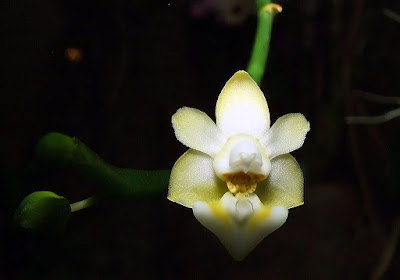The Phalaenopsis with a pouch-like swelling is native to Laos, northern and southern Vietnam. In the south of Vietnam, they grow between Saigon and Da Lat, in broadleafed, evergreen, lowland forests at elevations of sealevel to 1000 meters.
Phalaenopsis gibbosa orchid, also called as The Phalaenopsis with a pouch-like swelling, Doritis gibbosa, Polychilos gibbosa, is a species of the genus Phalaenopsis. This species was described by Herman Royden Sweet in 1970.
IDENTIFY PHALAENOPSIS GIBBOSA ORCHID
The Phalaenopsis with a pouch-like swelling is native to Laos, northern and southern Vietnam. In the south of Vietnam, they grow between Saigon and Da Lat, in broadleafed, evergreen, lowland forests at elevations of sealevel to 1000 meters.
It is a mini-miniature sized, hot to warm growing epiphyte with a short stem carrying a fan of 4 to 5, very broad oblong, deciduous leaves. The leaves are 13 cm long and are concave at the base.
Phalaenopsis gibbosa orchid blooms on a near leafless stem, a 6" (15 cm) long, branched, somewhat zigzag, several (8 to 10) flowered inflorescence occurring in the later winter and early spring. The small star-shaped flowers are 1.2 cm in diameter and are creamy white. The outer whorls are larger than the petals of the inner whorl, and all are fairly sharp. The lip has the shape of a triangle.
GROW AND CARE PHALAENOPSIS GIBBOSA ORCHID
Cultural information should only be used as a guide, and should be to be adapted to suit you. Your physical location; where you grow your plants, how much time you have to devote to their care, and many other factors, will need to be taken into account. Only then can you decide on the cultural methods that best suit you and your plants.
Light:
Phalaenopsis gibbosa needs a light level of 12000 lux and keep in partial shade.
Temperature:
The average summer temperature is 29-32 ° C, night 21-22 ° C, giving a daily difference of 8-9 ° C. In winter, the average day temperature is 23-31 ° C, at night 17-20 ° C, giving a daily difference of 11-13 ° C.
Humidity:
This plant needs the humidity of 80% throughout the year.
Substrate, growing media and repotting:
Best grow in pot with 12-16 mm fir bark. Plants are best repotted after flowering.
Watering:
Water about once a week.. Plants should always be very moist during the growing season. The precipitation pattern is wet/dry, but the high humidity level of natural habitats indicates that there is always additional moisture coming from dew, mists and drizzle.
Fertilizer:
It is recommended that 1/4-1/2 doses of fertilizer for orchids applied every week or every 2 weeks in the growing season.
Rest period:
In winter, plants should be provided with a 3-4 month dry, colder rest. At lower temperatures, the humidity should be reduced to 65-75%, and watering should be limited to very light watering every 2-3 weeks and occasional fogging. Plants can not, however, be dehydrated. During the winter dormancy the fertilization should be reduced or eliminated until the beginning of the growing season, but the level of light can be increased.















COMMENTS